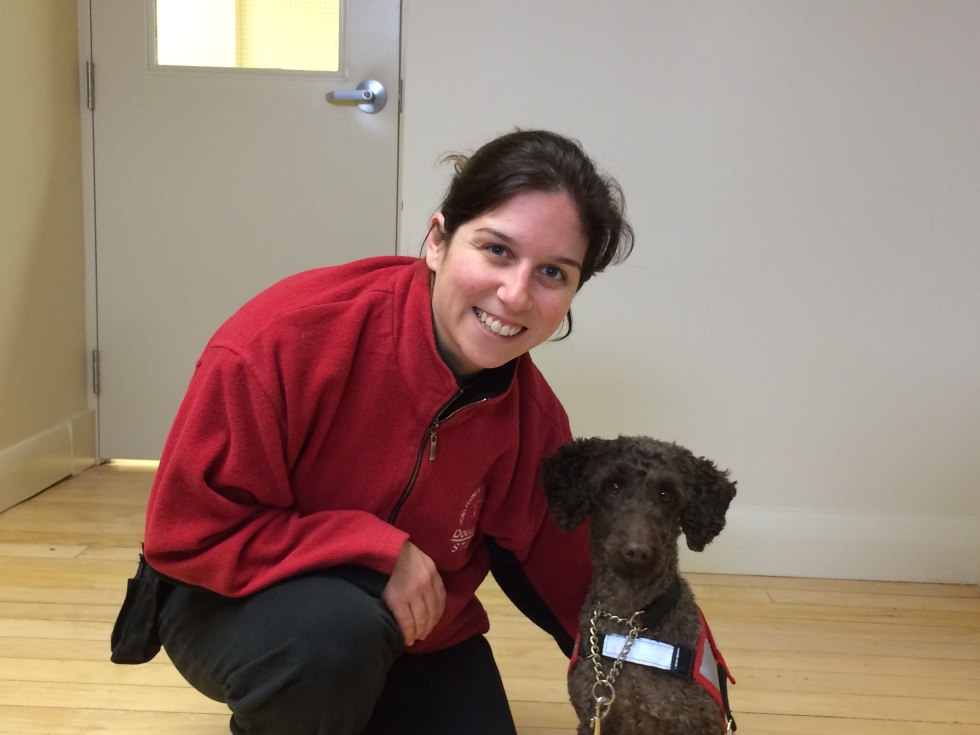From puppy to guide dog

Trainer Angela Bentivegna poses with one of her assigned dog guides on Nov.6 at the Lions Foundation facility in Oakville. (Photo by Samantha Maich / The Sheridan Sun)
STORY BY SAMANTHA MAICH
Oakville’s Lions Foundation of Canada for Dog Guides breeds, trains, and provides canine vision, hearing ear, seizure response, autism assistance, diabetic alert, and service guide dogs.
According to Alex Ivic, director of the dog guide programs, the foundation breeds around 250 puppies per year. At six to eight weeks old, the puppies are homed with foster families who teach the animals socialization and basic obedience. The temporary masters return monthly with the dogs for puppy classes.
At 12 months old, the animals return to the facility to be assigned a program and trainer based on personality, size, natural skills and behaviour. Three to six months are spent with a trainer learning tasks specific to their program.
MORE RELATED TO THIS STORY:
- A dog may be just what the doctor ordered
- Autism service dogs visit Sheridan
- Guide dogs lead the way for those in need
Ivic said that while they do have some volunteers taking care of the puppies, most training staff at the Lion’s Foundation are full-time, paid employees under a three-year apprenticeship.
“It’s pretty rewarding,” said Angela Bentivegna, special skills and hearing ear trainer. “I get to help them gain more independence.”
Bentivegna teaches basic obedience, how to behave in public, as well as the seven sounds hearing ear dogs need to know. These include fire alarms, kitchen timers, repeatedly calling someone’s name, etc.
When the dog hears a sound it has been taught, it is supposed to touch the trainer with its paw and bring them to the sound. The two exceptions include alarms when the dog spins in a circle, or alarm clocks when the animal wakes up the trainer for snuggles, said Bentivegna.
Bentivegna said each trainer is assigned around six to eight dogs. All the canines are kept at the facility, but take occasional trips to learn what will happen without the trainers present. The facility also has a resident cat to familiarize the dogs with distractions.
Bentivegna explained that after training, the facility matches dogs with clients based on the lifestyle of the handler, and the dog’s abilities and activity.
Prospective handlers fill out an application with a section from their doctor as a reference. They then have an in-home assessment to determine whether the match will be successful, and they are put on a waiting list.
The Lions Foundation will then fly or drive the prospective handler to the facility where they will spend up to a month learning how to maintain the training that has been set in place. Ivic said they hold a graduation for the handler and their new guide dog after.
According to Bentivegna, when a dog retires, the client may adopt it, but this may disqualify them from getting a new dog. Often, either family or friends of the client or trainers will adopt the retired dogs.
Gaelen Swartz, technical production for Theatre and Live Events student at Sheridan College, got his hearing ear dog guide, Gwen, in 2008 at the Lion’s Foundation. Swartz said that they didn’t tell him anything about the dog before meeting her. They left him in a room alone with the two-year-old guide dog, and she stood by the door the entire time, waiting for the trainer.
It wasn’t until Swartz started his training that he started bonding with Gwen through activities like holding the leash the right way. Swartz said that he would hold the leash loosely, while the trainer instructed him to hold it low and close to him.
“They trained me how to train the dog,” Swartz said, and explained that he could now train Gwen to new sounds if he needed to. For instance, hearing ear dog guides may be trained to respond to a baby crying.
Gwen’s typical day now consists of bonding with Swartz on his trips outside the house, but she mainly works at home for treats. Swartz said he needs to be careful of dangerous situations such as the spray booth used in one of his classrooms, but the only places that Gwen is not allowed are an operating room and intensive care unit.
Swartz and Gwen fought for the right to have a service dog in the School for the Deaf where Swartz used to attend. They changed the school’s policy and Gwen was the first service dog ever allowed there, according to Swartz.





One Response to From puppy to guide dog